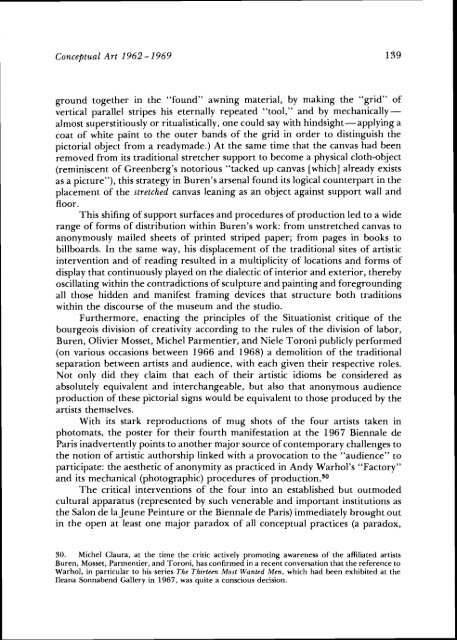Conceptual Art 1962-1969: From the Aesthetic of Administration to ...
Conceptual Art 1962-1969: From the Aesthetic of Administration to ...
Conceptual Art 1962-1969: From the Aesthetic of Administration to ...
Create successful ePaper yourself
Turn your PDF publications into a flip-book with our unique Google optimized e-Paper software.
<strong>Conceptual</strong> <strong>Art</strong> <strong>1962</strong>- <strong>1969</strong>ground <strong>to</strong>ge<strong>the</strong>r in <strong>the</strong> "found" awning material, by making <strong>the</strong> "grid" <strong>of</strong>vertical parallel stripes his eternally repeated "<strong>to</strong>ol," and by mechanicallyalmostsuperstitiously or ritualistically, one could say with hindsight-applying acoat <strong>of</strong> white paint <strong>to</strong> <strong>the</strong> outer bands <strong>of</strong> <strong>the</strong> grid in order <strong>to</strong> distinguish <strong>the</strong>pic<strong>to</strong>rial object from a readymade.) At <strong>the</strong> same time that <strong>the</strong> canvas had beenremoved from its traditional stretcher support <strong>to</strong> become a physical cloth-object(reminiscent <strong>of</strong> Greenberg's no<strong>to</strong>rious "tacked up canvas [which] already existsas a picture"), this strategy in Buren's arsenal found its logical counterpart in <strong>the</strong>placement <strong>of</strong> <strong>the</strong> stretched canvas leaning as an object against support wall andfloor.This shifing <strong>of</strong> support surfaces and procedures <strong>of</strong> production led <strong>to</strong> a widerange <strong>of</strong> forms <strong>of</strong> distribution within Buren's work: from unstretched canvas <strong>to</strong>anonymously mailed sheets <strong>of</strong> printed striped paper; from pages in books <strong>to</strong>billboards. In <strong>the</strong> same way, his displacement <strong>of</strong> <strong>the</strong> traditional sites <strong>of</strong> artisticintervention and <strong>of</strong> reading resulted in a multiplicity <strong>of</strong> locations and forms <strong>of</strong>display that continuously played on <strong>the</strong> dialectic <strong>of</strong> interior and exterior, <strong>the</strong>rebyoscillating within <strong>the</strong> contradictions <strong>of</strong> sculpture and painting and foregroundingall those hidden and manifest framing devices that structure both traditionswithin <strong>the</strong> discourse <strong>of</strong> <strong>the</strong> museum and <strong>the</strong> studio.Fur<strong>the</strong>rmore, enacting <strong>the</strong> principles <strong>of</strong> <strong>the</strong> Situationist critique <strong>of</strong> <strong>the</strong>bourgeois division <strong>of</strong> creativity according <strong>to</strong> <strong>the</strong> rules <strong>of</strong> <strong>the</strong> division <strong>of</strong> labor,Buren, Olivier Mosset, Michel Parmentier, and Niele Toroni publicly performed(on various occasions between 1966 and 1968) a demolition <strong>of</strong> <strong>the</strong> traditionalseparation between artists and audience, with each given <strong>the</strong>ir respective roles.Not only did <strong>the</strong>y claim that each <strong>of</strong> <strong>the</strong>ir artistic idioms be considered asabsolutely equivalent and interchangeable, but also that anonymous audienceproduction <strong>of</strong> <strong>the</strong>se pic<strong>to</strong>rial signs would be equivalent <strong>to</strong> those produced by <strong>the</strong>artists <strong>the</strong>mselves.With its stark reproductions <strong>of</strong> mug shots <strong>of</strong> <strong>the</strong> four artists taken inpho<strong>to</strong>mats, <strong>the</strong> poster for <strong>the</strong>ir fourth manifestation at <strong>the</strong> 1967 Biennale deParis inadvertently points <strong>to</strong> ano<strong>the</strong>r major source <strong>of</strong> contemporary challenges <strong>to</strong><strong>the</strong> notion <strong>of</strong> artistic authorship linked with a provocation <strong>to</strong> <strong>the</strong> "audience" <strong>to</strong>participate: <strong>the</strong> aes<strong>the</strong>tic <strong>of</strong> anonymity as practiced in Andy MTarhol's "Fac<strong>to</strong>ry"and its mechanical (pho<strong>to</strong>graphic) procedures <strong>of</strong> producti~n.~~The critical interventions <strong>of</strong> <strong>the</strong> four in<strong>to</strong> an established but outmodedcultural apparatus (represented by such venerable and important institutions as<strong>the</strong> Salon de la Jeune Peinture or <strong>the</strong> Biennale de Paris) immediately brought outin <strong>the</strong> open at least one major paradox <strong>of</strong> all conceptual practices (a paradox,30. Michel Claura, at <strong>the</strong> time <strong>the</strong> critic actively promoting awareness <strong>of</strong> <strong>the</strong> affiliated artistsBuren, Mosset, Parmentier, and Toroni, has confirmed in a recent conversation that <strong>the</strong> reference <strong>to</strong>Warhol, in particular <strong>to</strong> his series The Thirteen Most Wanted Men, which had been exhibited at <strong>the</strong>Ileana Sonnabend Gallery in 1967, was quite a conscious decision.
















